
9 Hanging Plants That Do Not Need Sunlight
The Best Hanging Plants for Low Light Spaces
I absolutely love having plants in every corner of my home, and if you’re into low-maintenance indoor greenery, you can check out my post on indoor plants that are hard to kill. Since so many of you enjoyed that article, I decided to share something similar: hanging plants that thrive with little to no sunlight.

While all plants need some light to survive, the ones I’m sharing here are perfect for those of us who don’t have bright sunlight pouring in all day. These plants are adaptable and can thrive in low-light environments, making them ideal for homes with limited natural light. Some prefer partial shade, while others do best in full shade. Be sure to check the details for each plant to choose the one that suits your space best.
So, without further delay, here are my top nine hanging plants that don’t need direct sunlight to thrive.
My Favorite Hanging Plants That Do Not Need Sunlight
Choosing the right plant for your home can depend on your room’s style and lighting. To help, I’ve picked a variety of hanging plants that are visually appealing and don’t require much sunlight. Enjoy exploring these options!
Bird’s Nest Fern (Asplenium nidus)
The Bird’s Nest Fern is a charming plant, known for its unique, wavy fronds. This plant does well in low-light conditions and is perfect for those looking for a hanging plant that doesn’t need direct sunlight. In fact, too much sun can damage its delicate leaves. It’s best placed in partial or full shade.
Bird’s Nest Fern (Asplenium nidus)
- Light: Partial to full shade
- Mature Size: Up to 3 ft. wide and 5 ft. tall
- Water: Keep the soil moist, but avoid sogginess
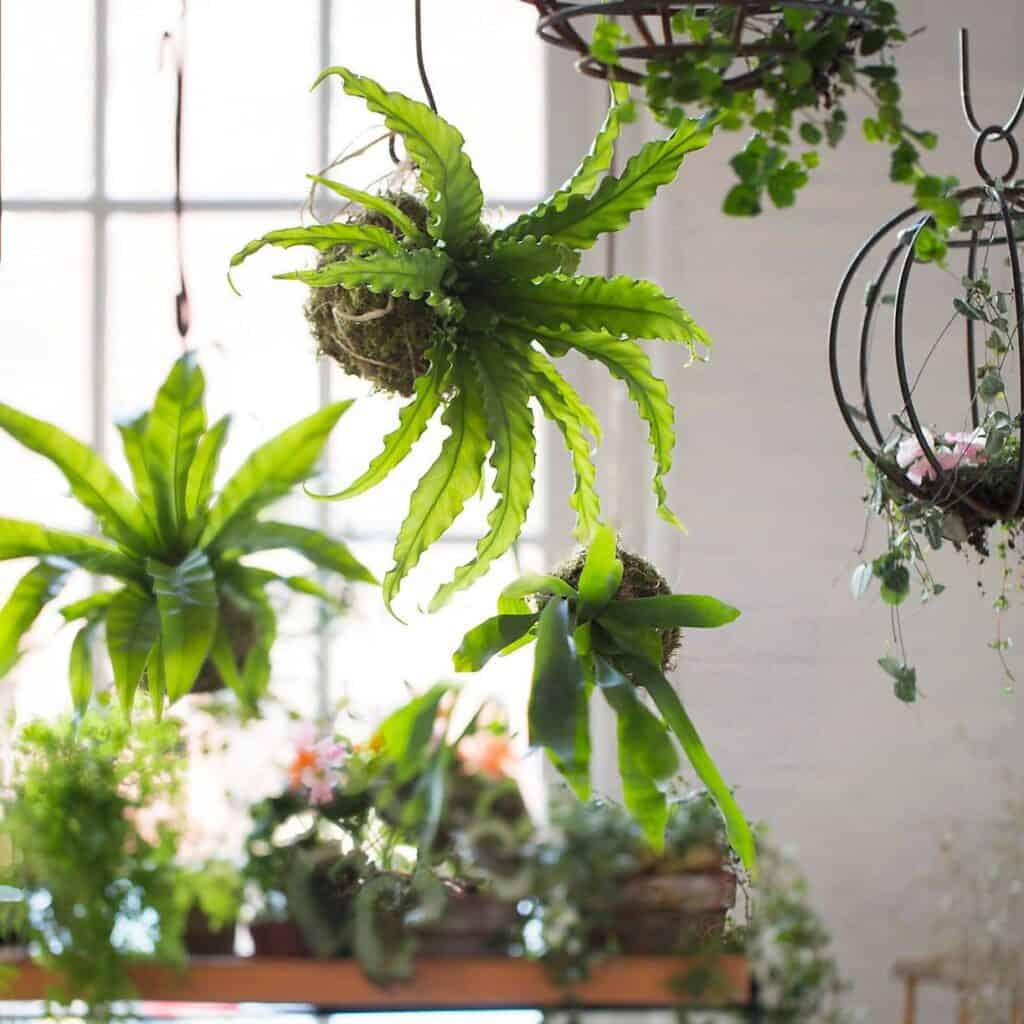
A great spot for this fern is the bathroom, where the humidity and warmth are ideal, though it will thrive in other rooms too. While it’s not the easiest plant to grow, it’s certainly manageable. With patience, you’ll see it grow up to 3 feet wide and 5 feet tall over time. Its slow growth rate gives you plenty of time to care for it properly.
Boston Fern (Nephrolepis exaltata)
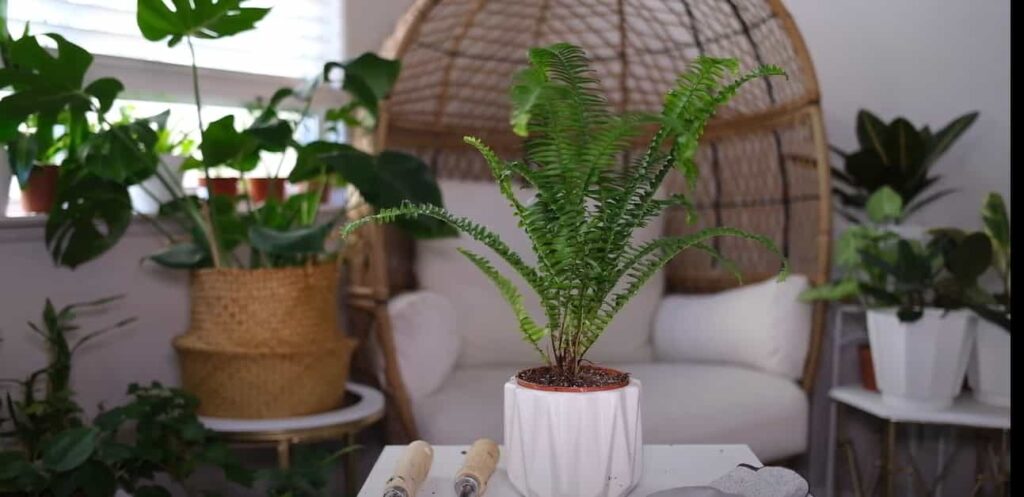
The Boston Fern is a classic choice for hanging planters, adding a lush, green touch to any room. This plant thrives in indirect light, making it an excellent option for areas of your home with limited sunlight.
Over time, the Boston Fern can grow to about 3 feet wide and 3 feet tall, though this slow growth allows you to adjust its placement in your home as it matures.
Keep in mind that the Boston Fern prefers warm and humid environments. If you’re growing it indoors, avoid placing it near heating or cooling sources, as these can damage the plant.
Boston Fern (Nephrolepis exaltata)
- Light: Indirect sunlight or light shade
- Mature Size: Up to 3 ft. wide and 3 ft. tall
- Water: Keep soil moist; avoid drying out
Spider Plant (Chlorophytum comosum)

The Spider Plant (Chlorophytum comosum) is a popular indoor hanging plant, known for its long, slender leaves with green and white stripes. These plants are a great option for smaller spaces, as they typically grow no taller than 2 feet, making them ideal for hanging planters.
This plant thrives in indirect sunlight or light shade. While it can adapt to low light conditions, it will grow more slowly in such environments. If you have dimmer areas, the Spider Plant will still manage well, though its growth might be slower.
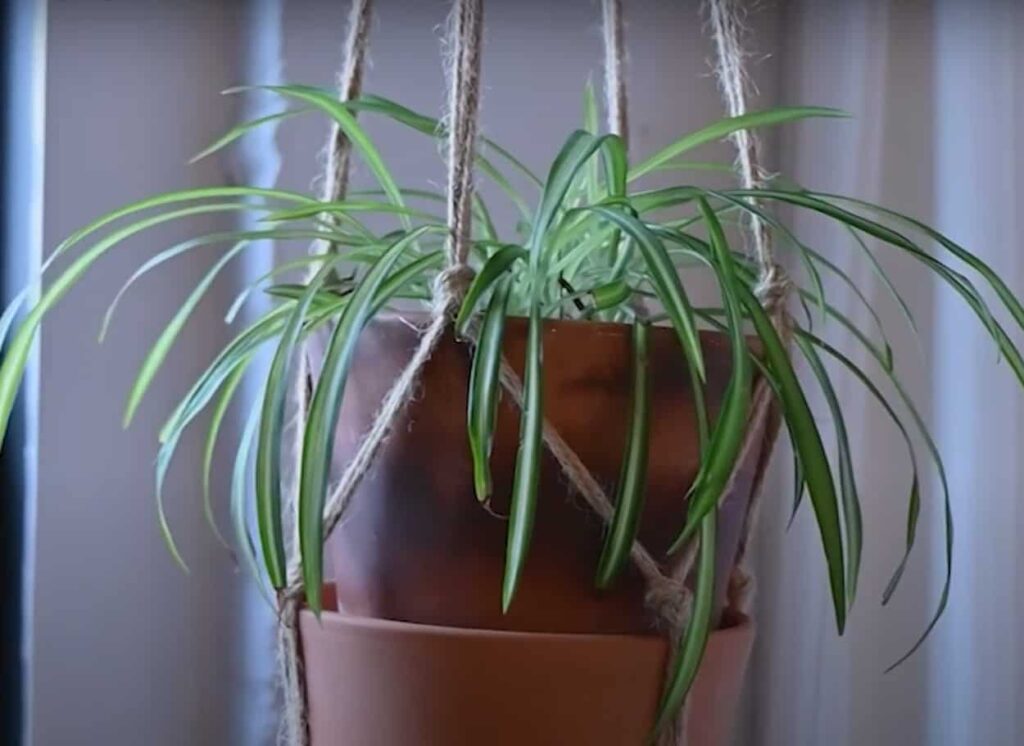
There are several varieties of the Spider Plant, each offering different leaf patterns and appearances. If you prefer a specific design, it’s worth exploring the different options available.
Spider Plant (Chlorophytum comosum)
- Light: Indirect light or light shade
- Mature Size: Up to 2 ft. tall
- Water: Water when the soil is dry; keep soil moist but not soggy
English Ivy (Hedera helix)

If you love the outdoors, English Ivy (Hedera helix) is a great choice to bring that natural vibe into your home. As a vine, it looks stunning in hanging planters and blends well with other shade-loving plants. Its subtle, green leaves add a soft touch to any space without overwhelming the decor.
For homes with limited sunlight, English Ivy is an excellent option, as it thrives in partial to full shade. If you have windows, place it near a north, east, or west-facing window to receive indirect light.
Even if you don’t have windows, English Ivy can survive under artificial light, although it still needs some light to maintain its color. Without light, its leaves may begin to lose their vibrant hue.
English Ivy (Hedera helix)
- Light: Full shade to partial shade
- Mature Size: Up to 4 ft. long
- Water: Keep the soil moist, but not overly soggy
Golden Pothos (Epipremnum aureum)
Golden Pothos (Epipremnum aureum) is a versatile, vining plant known for its ability to grow up to 30 feet long, even indoors. While most people trim it to a manageable size, this plant can also be used to create stunning natural archways or hanging features in your home.

Although it thrives in indirect bright light, the Golden Pothos is adaptable and can grow under fluorescent lighting alone, making it an ideal choice for rooms with limited natural light. It prefers high humidity, but it can also tolerate lower levels.
The key to successfully growing this plant is avoiding overly moist soil. Be sure to allow the soil to dry out completely between waterings. With these simple care guidelines, the Golden Pothos is a low-maintenance, easy-to-grow plant that will thrive in your home.
Golden Pothos (Epipremnum aureum)
- Light: Indirect light or fluorescent light
- Mature Size: Up to 10 ft. long (can be trimmed)
- Water: Allow soil to dry between waterings
Heartleaf Philodendron (Philodendron hederaceum)

The Heartleaf Philodendron (Philodendron hederaceum) is a charming plant known for its heart-shaped, dark green leaves, making it a popular choice for indoor spaces. This tropical plant is perfect for beginners due to its easy care requirements, thriving with just indirect natural light from a window.

As a tropical plant, the Heartleaf Philodendron prefers a humidity level of around 40%, but it can adapt to slightly lower levels. However, it should be kept in temperatures above 60°F to ensure optimal growth.
When watering, it’s important to use room temperature water to avoid shocking the plant’s root system. Typically, this plant only needs to be watered once a week, or when the soil has dried out. With these simple care tips, the Heartleaf Philodendron is an easy, low-maintenance addition to any home.
Heartleaf Philodendron (Philodendron hederaceum)
- Light: Low to bright indirect light
- Mature Size: Up to 4 ft. long
- Water: Water when the soil is dry, once a week
Monstera Adansonii (Swiss Cheese Plant)
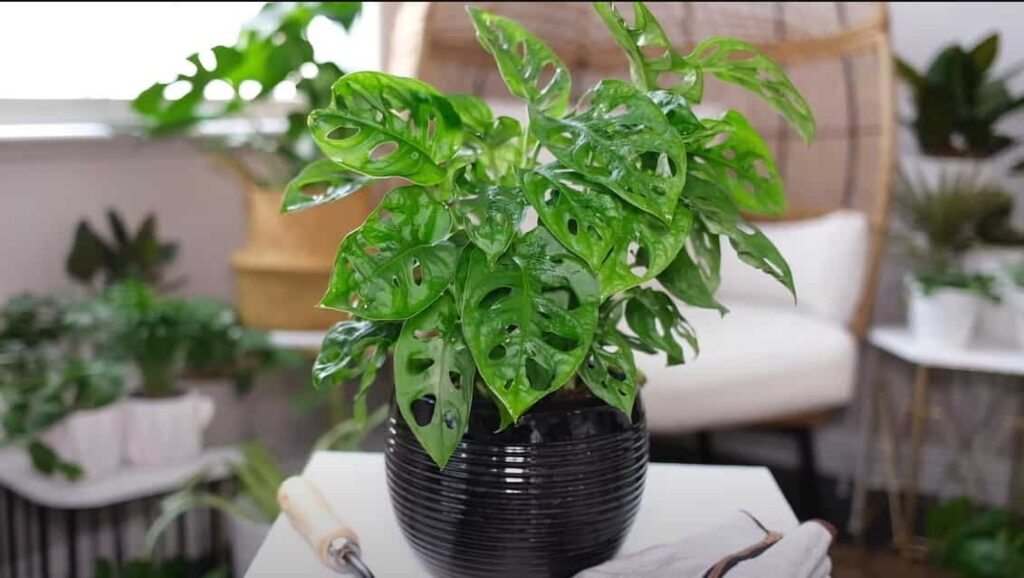
The Monstera Adansonii, commonly known as the Swiss Cheese Plant, is a popular choice for indoor décor, especially as a hanging plant. Its distinctive, perforated leaves make it a visually striking addition to any space.
This plant thrives in low-light conditions, making it ideal for rooms with indirect sunlight, such as the kitchen or bathroom, where it can also benefit from the appropriate temperature and humidity levels.
While it has a natural tendency to climb, you can control its growth by trimming it back with pruners. Unlike some other plants, the Monstera Adansonii prefers consistent watering. To check when it needs water, gently insert your finger about an inch into the soil—if it feels dry, it’s time to water. However, be cautious of overwatering, as yellowing leaves can indicate excess moisture.
Monstera Adansonii (Swiss Cheese Plant)
- Light: Low to bright indirect light
- Mature Size: Up to 4 ft. tall
- Water: Keep the soil slightly moist, but not soggy
Staghorn Fern (Platycerium bifurcatum)
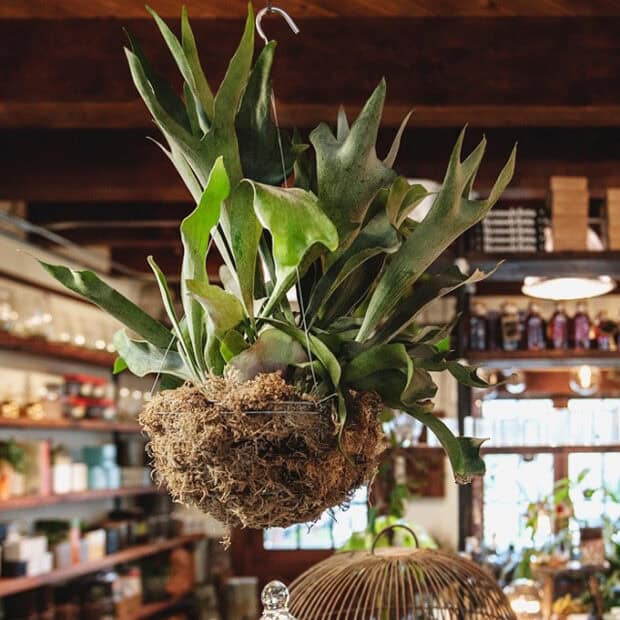
The Staghorn Fern (Platycerium bifurcatum) is a striking and sculptural plant often displayed on walls, making it a unique addition to your indoor space. Its name comes from its antler-like fronds, which resemble the horns of a stag.
This fern thrives in bright, indirect light and should be kept away from direct sunlight, which can damage its delicate leaves. A key feature of the Staghorn Fern is its shield fronds, which are small, brown leaves that protect the root ball and help the plant absorb nutrients. Though these fronds may appear dry or brown, they are essential for the plant’s survival and should not be removed.
With proper care, including the right light and moisture conditions, the Staghorn Fern can be a long-lasting and impressive plant in your home.
Staghorn Fern (Platycerium bifurcatum)
- Light: Bright, indirect light
- Mature Size: Up to 3 ft. wide
- Water: Keep the soil moist, but allow it to dry slightly between waterings
String of Pearls (Curio rowleyanus)
The String of Pearls (Curio rowleyanus) is an excellent option for brightening up darker corners of your home. This trailing plant features long vines adorned with small, pearl-like leaves, adding a touch of greenery and elegance to any space.

While it can flower with enough sunlight, the String of Pearls thrives in low light and can flourish with just indirect light from a nearby window, though blooming may be rare under such conditions.
Its distinctive shape and compact size make it an ideal addition to a potted plant collection. Whether placed in a hanging planter or trailing from a shelf, the String of Pearls brings natural beauty and texture to any room.
String of Pearls (Curio rowleyanus)
- Light: Partial to full shade
- Mature Size: Up to 3 ft. long
- Water: Water sparingly; let soil dry out between waterings
Key Considerations for Choosing Hanging Plants That Thrive Without Direct Sunlight
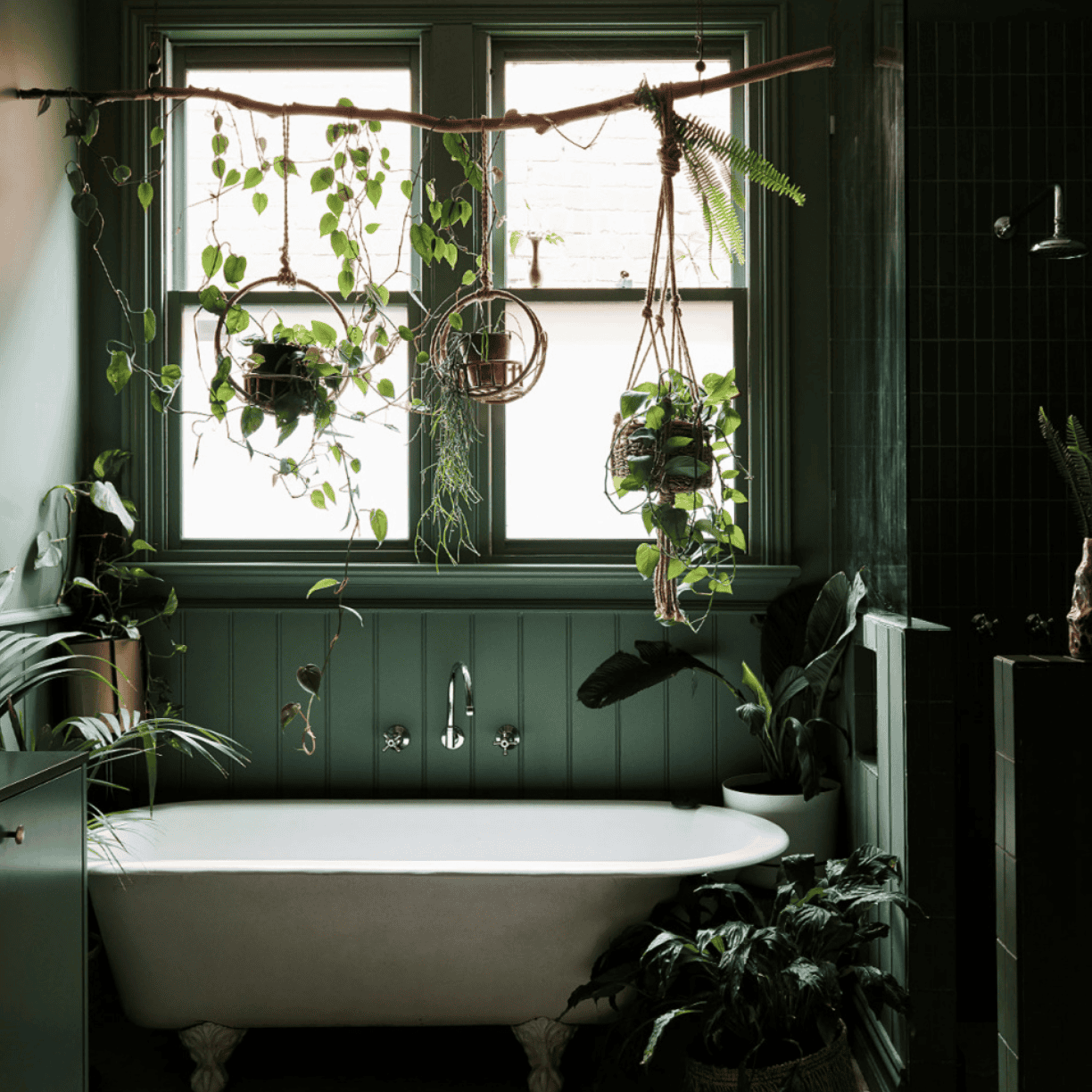
When selecting a hanging plant that doesn’t require direct sunlight, it’s important to keep a few key factors in mind to ensure it thrives in your home. Proper care is essential for your plant to look its best.
Lighting Requirements
While many low-light plants can survive in shaded or indirect light conditions, they still need some exposure to light. A room that is completely dark will not be suitable, as these plants still need a minimal light source to grow. If your space lacks natural light, consider using artificial lighting to support plant health.
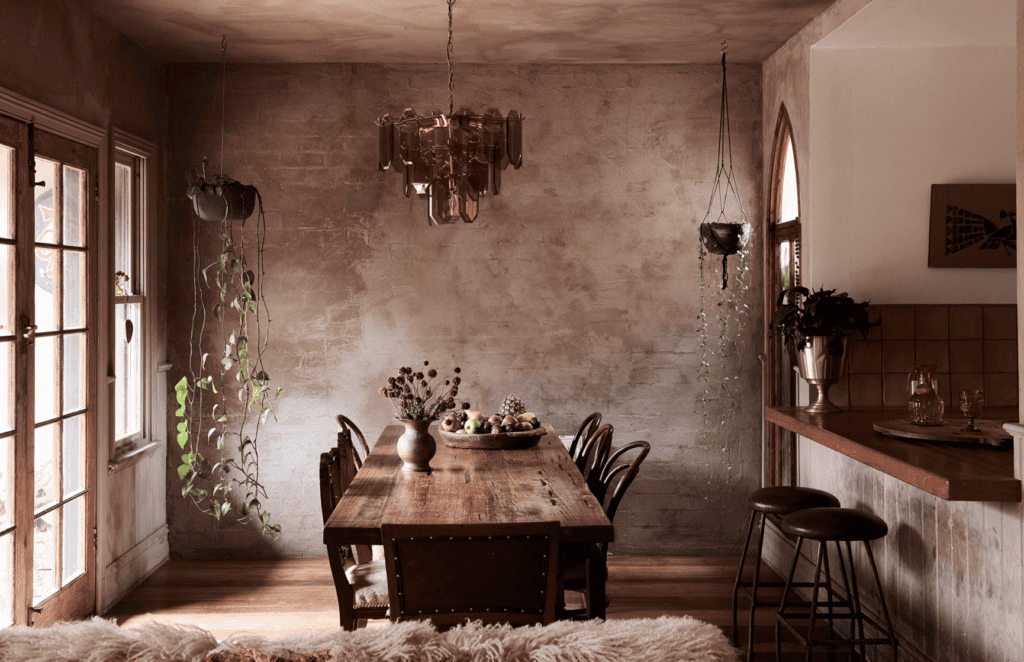
Conversely, if your room receives too much direct sunlight, you may need to relocate your plant or use window coverings like blinds or drapes to diffuse the light.
Watering Needs
Not all plants have the same watering requirements. Some may need more frequent watering, while others may require much less. Even the plant’s location can influence how often it needs water. To stay organized, consider grouping plants with similar watering schedules together. This will make it easier to remember when to water each plant, helping them thrive consistently.
Environmental Factors
The location of your plant plays a significant role in its temperature and humidity needs. If you cannot place your plant in its ideal environment, you may need to adjust the room’s conditions using a humidifier or dehumidifier to maintain the right balance. For temperature-sensitive plants, ensure that they’re not exposed to extreme heat or cold.
Growth Potential
While your plant may start off small, it could eventually outgrow its current space. Be prepared to relocate your plant to a larger pot or even consider outdoor space or a greenhouse if necessary. For plants that remain small, you have more flexibility in choosing their location. For example, placing small plants on a bookcase or shelf can create a lovely decorative display while saving space.
By considering these factors—lighting, watering, environmental needs, and growth potential—you can ensure that your hanging plants thrive and enhance your home for years to come.
Frequently Asked Questions About Hanging Plants That Do Not Need Sunlight
Are there any plants that don’t need any sunlight?
All plants require some light to survive. However, some hanging plants on this list need only partial, indirect sunlight or can grow with fluorescent lights. For rooms with no natural light, you can use a grow lamp to support plant growth.
Are there any flowering plants that do well in shade?
Yes, Bleeding Heart is a flowering plant that thrives in the shade and can be a great addition to your collection, even though its blooms last only a few weeks.
What can I grow on a shady balcony?
On a shady balcony, you can grow vines, ferns, mini trees, and flowers. Look for plants that prefer partial or full shade, and use pots or metal plant hangers to save space.
What is the fastest growing plant in shade?
Some fast-growing plants in shade include Aloe Vera, Split Leaf Philodendron, and Spider Plant.
What flowers are best for pots in shade?
Butterfly Peas, Bleeding Hearts, and Clematis are all ideal flowering plants for shady pots.